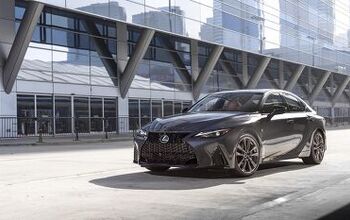Ask The Best And Brightest: How Can Honda Have Its Cake And Eat It Too?
Pity Takanobu Ito. Like many (ok, some) of us, the CEO of Honda is torn between his love for speed and the desire to be perceived as environmentally responsible. On the one hand, he lambasted Toyota for building its $375k LF-A supercar, saying that to his mind the fuel-cell FCX clarity (once described by Jonny Lieberman as “exactly like a Honda Accord”) was his idea of a modern sports car. On the other, “I would like to make a sports car,” Ito tells Automotive News [sub]. “Once we have that technology and once we have cash on hand, I would like to see Honda have a sports car that symbolizes our technology.” Is he referring to the forthcoming CR-Z? Because, as cool as that car looks, it will hardly satisfy the LF-A jealousy we detect in Mr Ito’s voice. And you have to imagine that the creator of the NSX is as qualified as anyone else to design and develop the first 21st Century green sportscar. But what would that look like? Assume any price point up to the LF-A’s insane $375k sticker, and give us some specs. And remember, at this point, green is relative… and quantifiable only in terms of marketing.
More by Edward Niedermeyer


































Comments
Join the conversation
Can Honda just build an rx-8 with a nice,high revving honda engine (prefer the v-6) for about 30k. Then I could finally get the affordable sports car I want.
Just looking at the NSX picture above, an interesting thought strikes me about Honda. The time period when NSX was made, between early 90s and 2000s, was roughly the time of highest point of Honda's brand, in the sense of being on the edge of technology, design, and being one step ahead of most competitors. It's been going mostly downhill since then. We can clearly perceive the following trends. Acura has decidedly gone downhill. The horrible recent design pattern, the insistence on FWD in many models, endless stream of pretty ordinary CUVs, the blandness of RL, etc. NSX got axed without a replacement. Nissan, Cadillac, and Lexus are now making successful quasi-supercars, some in former NSX price range, but Acura seems absent in that segment. Acura is simply not in the same league with Infinity and Lexus any more. Next, Honda itself is becoming less interesting compared to its competition. The Accord is still a good car, but it is hard not to think of "Camrification" of it. Big, bloated, expensive. Accord is not the only car suffering from this Camrification trend. Subaru and Mazda have also gone the same way. These days I find cars like Sonata, Fusion, or Malibu far more attractive than Accord. Odyssey, Fit, and Civic are arguably the only cars across Honda/Accord lineup that are still living up to its 1990s brand image.
The CR-Z Hybrid really sounds like a good idea. I would have thought that Honda would have offered the same engines in the CR-Z as they do in the Civic, the 4-cylinder from the conventional Civic, and the more powerful engine from the Si. I would have thought they would drop right in. Maybe an Si version is coming down the road following the introduction of the Hybrid version. I've seen where hot rodders have dropped Si engines into heavily reworked versions of the original 2-seat Insight and they look pretty cool, like what Honda should have produced all along.
Toyota already had a great idea for a 'green' sports car but never did anything with it (Toyota Volta). Honda could take that idea and actually put it into production. Hree is some info about it that can easily be found on the net: From the “tragically cool” department, check out Toyota Volta. The Volta uses a carbon-fiber body and seats three. In the case of Volta, the three people sit side-by-side—and get this—the “drive-by-wire” controls allow you to position the steering wheel and pedals in front any one of them. On the Volta, a 3.3 liter V6 gas engine is located behind the rear axle and is not connected directly to the wheels. Instead, movement is provided by two electric engines, one per axle, offering the safety benefits of all-wheel drive. But the real gain of packaging a large internal combustion engine with two electric motors is rip-roaring speed: a 408 horsepower hybrid drive that can achieve 0 – 60 acceleration in 4 seconds. Despite this level of power, the fuel economy will reportedly exceed 30 miles per gallon. At low speeds, any of those three drivers can switch manually to all-electric mode. Toyota partnered with the famed automotive design firm Italdesign-Giugiaro to create the Volta concept prototype. Italdesign-Giugiaro and Toyota were a good match in terms of technology and design, and at an historical level. The Volta draws its name from the Italian inventor Alessandro Volta, who invented the electric battery in 1800. Creating the hybrid concepts of the future wouldn’t be possible without the achievements of Count Volta. He certainly could never have imagined that his experiments with charges of electricity might help spark a revolution in transportation.